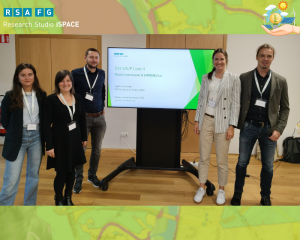
Key Researcher Ingrid Schardinger (2. f. l.) in Stegersdorf.
The role of the regions in the national energy transition was the topic of this year’s Mission Innovation Austria Week 2024 in Stegersbach in Burgenland. The session on ‘Spatial energy planning as the key to measure-based municipal Co2 reduction pathways’ presented the results of the GEl S/E/P I and II project bundle. The Smart Energy Balances working group from the iSPACE studio was also involved in the projects. Key researcher Ingrid Schardinger presented the overall approach of the project bundle (S/E/P method) in her lecture and gave a live insight into the resulting ENERGIEatlas.
While GEL S/E/P I (2018-2021) focussed on the heating sector, GEL S/E/P II (2021-2024) expanded to include the electricity and mobility sectors. The S/E/P method was developed using data from Salzburg, Styria and Vienna. Key project results are the ENERGIEatlas and automated reports for municipalities and, in Vienna, for districts. These results now provide a sound basis for spatial energy planning. The presentation on the ENERGIEatlas aroused great interest among those present, as did the question of when and whether the ENERGIEatlas will be available for other federal states.
The session also presented existing tools in the heating sector and discussed the status quo for mobility and electricity. The Gleisdorf climate protection plan and energy inventory analysis in the spatial development concept for Salzburg were presented as application examples and further practical experiences in Salzburg and Styria were discussed, also with regard to legal issues.

